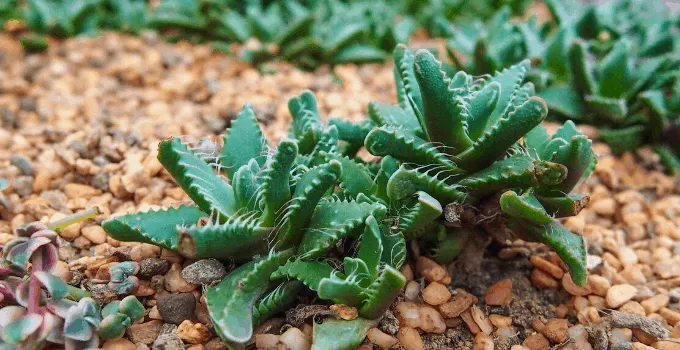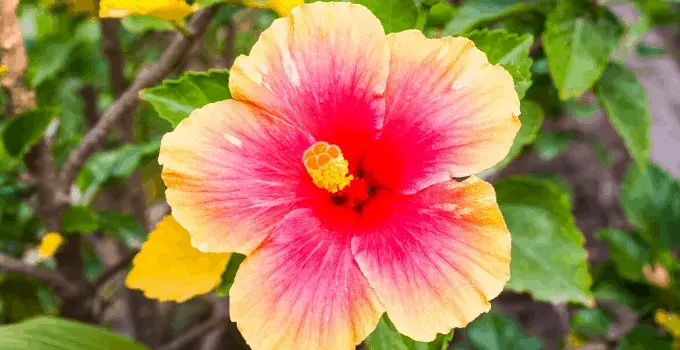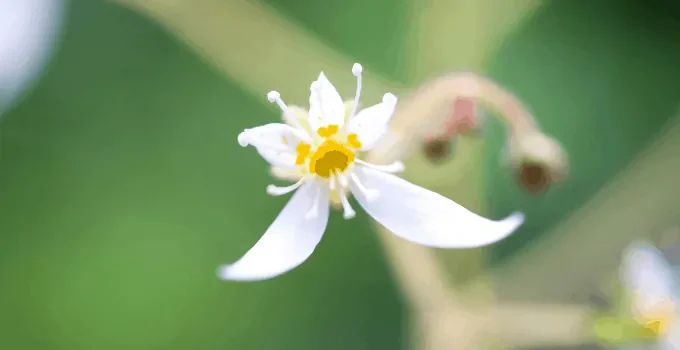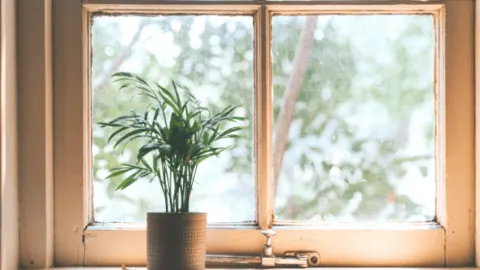Some plants love full sun, while yet others won’t tolerate direct sunlight and are likely to die if too much light is provided.
So, when growing houseplants, you need to be very careful about the right location for your plant, as ultimately, the location you choose for your plant, will decide on how much light your plant is exposed to.
That said, let us now talk about the best plants for west-facing windows.
West-facing windows are best for plants that are in need of medium light.
West-facing windows receive less light than south-facing windows.
However, plants in west-facing windows still receive intense, direct sunlight for half a day (afternoon) when placed very near that window.

Best Plants for West-Facing Windows
Table of Contents
So, what are the best plants for west-facing windows?
Some of the best plants for west-facing windows include Aechmea fasciata (Urn plant), Aphelandra squarrosa (Zebra plant), Araucaria heterophylla (Norfolk Island Pine), Chamaedorea elegans (Parlour palm), Cordyline terminalis (Ti Plant), Crassula ovata (Jade plant), Cypripedioideae (Lady’s Slipper Orchids), Dieffenbachia (Dumb Cane), Dracaena fragrans (Corn plant), Echinopsis (Hedgehog cactus), Faucaria tigrina (Tiger Jaws), Hibiscus rosa-sinensis (Chinese Hibiscus), Mammillaria elongata (Gold Lace Cactus) & Saxifraga Stolonifera (Strawberry Begonia).
Best plants for west-facing windows
1. Aechmea fasciata (Urn Plant)

Aechmea fasciata, also known as the “Urn plant”, is the first plant on our extensive list of plants that do particularly well when placed in west-facing windows.
West-facing windows are known to provide a half-day of full sun, which is actually not something that is ideal for Urn plants.
So why are Urn plants still considered to be good plants for west-facing windows, then?
Well, Urn plants like bright, indirect sunlight.
Now, west-facing windows definitely do provide that.
But you should make sure that your Urn plant only receives filtered light.
And, as west-facing windows do provide a half-day of full sun (afternoon), you will need some curtains to ensure that your plant only receives filtered light.
Direct sunlight is not good for your Aechmea fasciata, as this will burn its leaves.
2. Aphelandra squarrosa (Zebra Plant)

Aphelandra squarrosa is not a fan of direct sunlight.
In fact, this plant does not tolerate direct sunlight at all.
Now, could this plant still feel comfortable in a west-facing window, knowing that west-facing windows generally provide a half-day of full sun?
And the answer is yes. Just make sure that you have a curtain between your west-facing window and your plant and you will end up with what this plant needs to thrive: Bright light without direct sunlight.
3. Araucaria heterophylla (Norfolk Island Pine)

Norfolk Island Pine Trees are famous for making excellent Christmas trees.
But what you probably didn’t know is that they also make great houseplants.
Now, while the preferred location for Norfolk Island Pines is actually a south-window (they love intense, direct sunlight), a west-window that gets a good amount of bright, direct sunlight should also yield good results.
4. Chamaedorea elegans (Parlor palm)

The Parlor palm is one of these forgiving houseplants that can actually tolerate low light conditions.
In that sense, it is pretty similar to other low-maintenance houseplants such as the Spider plant and the popular ZZ plant.
But that doesn’t mean that low light is actually the ideal choice when it comes to the Parlor palm.
In fact, bright, indirect light yields the best results with Chamaedorea elegans.
This makes the Parlor plant a suitable plant for a west-facing window, provided that you will shield your Parlor plant from the direct sunlight that west-facing windows are usually getting in the afternoon.
To do so, once again, hang a curtain between your plant and the window and voilà, your plant does now only receive filtered light.
5. Cordyline terminalis (Ti Plant)

Cordyline terminalis (Ti plant) comes in many color variations: green, red, orange, or, as in the picture above, in pink.
Now, while most Ti plants can indeed survive in low light, not being exposed to enough light will result in less lively Ti plants, especially if you own a variegated Ti plant.
This is why it is recommended to keep your Cordyline terminalis in a spot that blesses your plant with bright light (mainly indirect light with some direct sunlight each and every day).
A west-facing window is, therefore, certainly a good choice, especially if you are growing a variegated ti plant.
Variegated plants generally need more light than their regular counterparts.
6. Crassula Ovata (Jade Plant)

The all-so popular Jade plant that you can see in many people’s homes, in public places, and even in shopping centers and the like, is yet another plant that does great in west-facing windows.
It does enjoy medium light, which is a good deal of filtered light and is, therefore, perfect for exposure in west-facing windows.
7. Cypripedioideae (Lady’s Slipper Orchids)

While orchids as a whole are plants that do best when placed in south-facing windows, some orchids, such as Lady’s Slipper orchids prefer somewhat less light.
So, you could very well keep this beautiful orchid in a west-facing window. Just make sure that it does not receive direct sunlight, as it won’t tolerate it all that well.
As west-facing windows do indeed receive a good amount of direct sunlight, you should make sure to shield your plant from direct sunlight with the help of a curtain.
8. Dieffenbachia (Dumb Cane)

Dieffenbachia (Dumb Cane) probably doesn’t even need an introduction, as it is easily one of the most popular houseplants at this day and age.
Dieffenbachia care is relatively easy.
As far as light requirements go, Dieffenbachia feels most comfortable in medium light.
It is, therefore, a good idea to grow this plant in a west-facing window, where it receives lots of bright, indirect light.
Filtered light through a curtain would be ideal.
Attention: Keep this plant away from your cats & dogs, as this plant is classified as toxic by the ASPCA.
9. Dracaena fragrans (Corn Plant)

Corn Plant is a very forgiving houseplant that is very easy to grow, even for complete beginners.
As far as the right temperature and the right watering schedule goes, your Corn Plant is considered to be very low-maintenance and even if your care is not exactly on point, your Dracaena fragrans is most likely to survive.
Now, as far as light requirements go, Corn Plant is equally forgiving and will do well in a wide range of locations and light conditions.
Still, if you would like to like your plant to reach its full potential, you should place is either in an east- or west-facing window, as a half-day of full sun is what Dracaena fragrans likes best.
As we have discussed earlier on, both an east- and west-facing window can deliver a half day of full sun, the difference being that the east-facing window will deliver high light in the morning, whereas a west-facing window shines with high light in the afternoon.
As for other aspects of Corn plant care, please have a look at our in-depth Corn plant care guide.
10. Echinopsis (Hedgehog Cacti)

Cacti generally love the sun. Some of these desert-dwellers even welcome a full day of sun.
And whenever a full day of sun is mentioned, your best bet would be placing the plant in a south-facing window.
Some Cacti, as our Hedgehog Cactus, however, prefer medium light and can’t handle a full day of direct sun.
They are OK with what east-facing or west-facing windows have to offer, though: A half-day of full sun.
11. Faucaria tigrina (Tiger Jaws)

The Tiger Jaw plant is a succulent. And both succulents and cacti generally need a lot of sunshine to thrive. This also holds true for the Tiger Jaw.
As these plants actually enjoy a full day of sun, a south-window would be the perfect fit for them.
However, a west-window is probably the second-best option for these succulents, as they are still supposed to do very well with even just a half-day of sun.
If you want to see your Tiger Jaw bloom, you’ll need to make sure that it receives about 3-5 hours of direct sunlight per day.
12. Hibiscus rosa-sinensis (Chinese Hibiscus)

Hibiscus rosa-sinensis feature some of the most impressive blooms you’ll ever see in houseplants.
As far as the colors go, you will find many different Hibiscus Rosa-Sinensis varieties on the market: pink, blue, yellow, and some varieties with striking bicolors.
Hibiscus rosa-sinensis plants enjoy warmth and do best in warm temperatures.
They are best grown near west-facing windows, where they can enjoy bright light with some direct sun in the afternoon.
13. Mammillaria elongata (Gold Lace Cactus)

This pretty desert-dweller will be most happy to receive a half-day of direct sun from a west-facing window.
As an alternative, you could also place it in an east-facing window where it gets direct morning sun rather direct sunlight in the afternoon (=west-facing window).
Mammillaria elongata is native and endemic to Mexico. It is one of the most popular species in the genera of Mammillaria within the family Cactaceae.
14. Saxifraga stolonifera (Strawberry Begonia)

When grown indoors, Saxifraga stolonifera does particularly well in two locations: East-facing windows or west-facing windows.
It needs lots of bright, indirect light but also needs some direct light. As we know, both east- and west-facing windows can deliver that.
If possible, avoid exposing your Strawberry begonia to too much midday sun, as this might result in bleaching of the leaves.
In fact, not only the Strawberry begonia is a great candidate for west-facing windows, but also many other species in the Genus Begonia do extraordinarily well in west-facing windows.
Frequently Asked Questions About West-Facing Windows Plants
How much light does a west-facing window get?
West-facing windows are characterized by receiving a half-day of full sun (afternoon). West-facing windows are providing your plant with medium light.
Is a west-facing window a good choice for a banana tree?
No. A banana tree generally does better in a south-facing window where it gets bright light (direct sunlight).
Is the Areca palm a good plant to grow in west-facing windows?
No. Areca palms love intense, direct sunlight. For best results, place your Area palm in a south-facing window!

Daniel has been a plant enthusiast for over 20 years. He owns hundreds of houseplants and prepares for the chili growing seasons yearly with great anticipation. His favorite plants are plant species in the Araceae family, such as Monstera, Philodendron, and Anthurium. He also loves gardening and is growing hot peppers, tomatoes, and many more vegetables.


